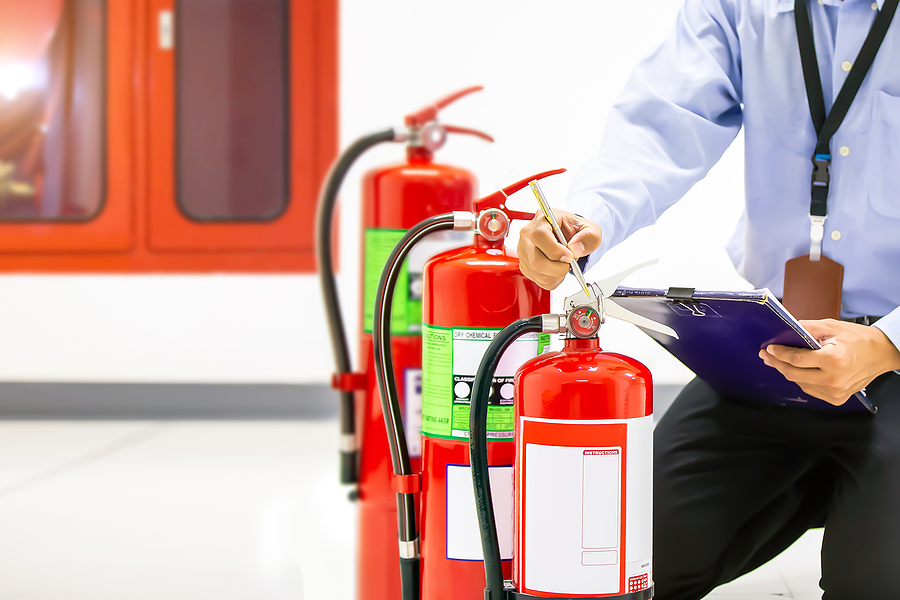As a business owner, ensuring your establishment is properly equipped to handle potential fire hazards should be a top priority. A key part of any fire safety plan is having accessible, working fire extinguishers that employees know how to use. Maintaining these extinguishers regularly is crucial for them to function properly when needed. This comprehensive guide will walk you through everything you need to know about keeping your business’s fire extinguishers in working order.
Types of Fire Extinguishers
Not all fire extinguishers are created equal. There are several different types designed to combat specific types of fires:
- Class A extinguishers put out fires involving ordinary combustibles like wood, paper, plastics, fabric, etc. They contain pressurized water or foam.
- Class B extinguishers work on flammable liquid fires from oils, gasoline, paints, tars, etc. They contain dry chemical agents.
- Class C extinguishers combat fires involving live electrical equipment and wiring. They contain non-conductive agents.
- Class D extinguishers are made for combustible metal fires from magnesium, sodium, aluminum, etc. They contain special powders.
- Class K extinguishers specifically handle fires from cooking oils and fats in commercial kitchens. They contain wet chemicals.
Every fire extinguisher should have clear labels stating what classes of fires it can be used on. Make sure you have the proper types placed strategically around your business in the necessary locations.
Monthly Visual Inspections
All commercial fire extinguishers need to undergo quick monthly inspections to ensure they remain functional, accessible, and have not been tampered with or damaged. Trained employees should check the following:
- The extinguisher is still in its designated location, mounted, and visible/accessible.
- Lock or tamper seal is still intact.
- No obvious physical damage, leaks, rust, or clogs in the hose.
- Pressure gauge (if present) indicates adequate pressure.
- Pin and safety seals are firmly in place.
If anything is found wrong with the extinguisher during monthly inspections, immediate corrective action needs to take place. If an extinguisher requires recharging or replacement, swap it out for a spare while servicing. Keep logs of all monthly inspections.
Annual Maintenance
In addition to monthly checks, commercial fire extinguishers require annual maintenance procedures conducted by certified professionals. Annual maintenance entails fully examining and servicing the extinguishers to certify their functionality. Steps include:
- A complete visual examination checking for any signs of damage, leaks, corrosion, clogs, etc. Any defective parts will be replaced.
- Weighing extinguishers to confirm fullness based on weight specifications.
- Pressure testing extinguishers (for those needing it) to ensure proper pressure levels.
- Testing safety pins, nozzles, discharge valves, and hoses for full operation.
- Cleaning extinguisher shells if dirt, oil residue, or salt buildup is present.
- Recharging any extinguishers found less than full during inspection. This entails adding fresh extinguishing agent and pressurizing the interior.
- Affixing a maintenance tag with the service date and initials of the technician.
Annual maintenance also requires keeping detailed servicing records for reference and fire department reporting purposes.
Hydrostatic Testing Every 5 or 12 Years
Depending on the type of extinguisher, full hydrostatic testing needs to occur at larger intervals – every 5 or 12 years. During hydrostatic testing:
- The extinguisher cylinder is placed in a certified pressure vessel filled with water.
- Pressure is then applied at levels far exceeding normal specifications.
- The cylinder is examined for any leaks, bulges, cracks, or other defects while pressurized.
- If no defects are found, it passes. If defects are found, it fails and must be replaced.
- A new hydro test date stamp will be applied to note the next test deadline 5 or 12 years in the future.
Hydrostatic testing ensures cylinders remain completely safe to withstand high pressures over time. Fire extinguisher specialists have the proper equipment to conduct hydro testing.
Workplace Ready Inspections
In addition to routine maintenance procedures done by professionals, employees should be trained on doing quick checks to always keep workplace fire extinguishers inspection ready. Their inspections should verify:
- Proper mounting in an easily accessible location.
- No obstructions blocking access to the extinguisher.
- Pressure gauges showing adequate pressure (if applicable).
- Pins and seals are fully in place with no signs of tampering.
If anything is found amiss, they must alert the proper personnel to schedule corrective maintenance.
Fire Extinguisher Training
Simply having functional, maintained extinguishers around your business is not enough for preparation. You must provide all new and existing employees with recurring hands-on fire extinguisher trainings. These 30-60 minute sessions should teach:
- The different extinguisher types and their associated uses.
- How to check if an extinguisher is fully charged and free of defects.
- Proper techniques for safely operating extinguishers using the PASS method (pull, aim, squeeze, sweep).
- Allowing all employees to get experience discharging extinguishers in a controlled environment.
Document all training sessions provided including the topics covered, the dates conducted, and names of participating employees.
Install visible extinguisher use instruction signs showing concise operating directions with pictures above any located extinguisher as an extra reminder.
Emergency Replacement Protocol
Despite preventive maintenance, unexpected fire extinguisher issues requiring immediate replacement can still arise. Develop emergency protocols detailing:
- Where to procure loaner rental extinguishers on short notice if repairs take longer.
- How to thoroughly communicate temporary replacement locations to all staff.
- Procedures for quickly restoring permanent extinguishers to service.
Following prudent extinguisher maintenance best practices for your industry paired with safety education will help ensure your establishment stays sufficiently equipped and protected in the event of any fire emergency. Protect your business, staff, and customers by making extinguisher maintenance a priority.
